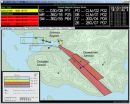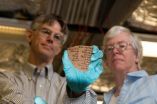(Press-News.org) Researchers have long known that individual diseases are associated with genes in specific locations of the genome. Genetics researchers at the University of North Carolina at Chapel Hill now have shown definitively that a small number of places in the human genome are associated with a large number and variety of diseases. In particular, several diseases of aging are associated with a locus which is more famous for its role in preventing cancer.
For this analysis, researchers at UNC Lineberger Comprehensive Cancer Center catalogued results from several hundred human Genome-Wide Association Studies (GWAS) from the National Human Genome Research Institute. These results provided an unbiased means to determine if varied different diseases mapped to common 'hotspot' regions of the human genome. This analysis showed that two different genomic locations are associated with two major subcategories of human disease.
"Our team is interested in understanding genetic susceptibility to diseases associated with aging, including cancer," said PhD student William Jeck, who was first author on the study, published in the journal Aging Cell.
The team examined the large NHGRI dataset and first eliminated hereditable traits such as eye or hair color and other non-disease traits like drug metabolism. The group then focused on variants identified from GWAS that contributed to actual diseases. Combining results from all of these studies, there was enough data to arrive at statistically valid conclusions. The team then mapped the disease associations to the appropriate locations of the genome, counting the number of unique diseases mapping to specific genomic regions, in order to see if disparate diseases mapped randomly throughout the genome, or clustered in hotspots.
"What we ended up with is a very interesting distribution of disease risk across the genome. More than 90 percent of the genome lacked any disease loci. Surprisingly, however, lots of diseases mapped to two specific loci, which soared above all of the others in terms of multi-disease risk. The first locus at chromosome 6p21, is where the major histocompatibility (MHC) locus resides. The MHC is critical for tissue typing for organ and bone marrow transplantation, and was known to be an important disease risk locus before genome-wide studies were available. Genes at this locus determine susceptibility to a wide variety of autoimmune diseases such as arthritis, celiac disease, Type I diabetes, asthma, psoriasis, and lupus," said Jeck.
"The second place where disease associations clustered is the INK4/ARF (or CDKN2a) tumor suppressor locus. This area, in particular, was the location for diseases associated with aging: atherosclerosis, heart attacks, stroke, Type II diabetes, glaucoma and various cancers." he added.
"The finding that INK4/ARF is associated with lots of cancer, and MHC is associated with lots of diseases of immunity is not surprising—these associations were known. What is surprising is the diversity of diseases mapping to just two small places: 30 percent of all tested human diseases mapped to one of these two places. This means that genotypes at these loci determine a substantial fraction of a person's resistance or susceptibility to multiple independent diseases," said Ned Sharpless, MD, Wellcome Distinguished Professor of Cancer Research and Associate Director of Translational Research at UNC Lineberger.
Another interesting finding was the apparent role of two biological processes in multi-disease association. In addition to the MHC and INK4/ARF loci, five less significant hotspot loci were also identified. Of the seven total hotspot loci, however, all contained genes associated with either immunity or cellular senescence. Cellular senescence is a permanent form of cellular growth arrest, and it is an important means whereby normal cells are prevented from becoming cancerous. It has been long known that senescent cells accumulate with aging, and may cause aspects of aging. This new analysis provides evidence that genetic differences in an individual's ability to regulate the immune response and activate cellular senescence determine their susceptibility to many seemingly disparate diseases.
"We call the absence of disease 'wellness', and our results suggest the genetics of wellness may be much more simple than previously suspected. Put another way, these unbiased data from about two million people suggest that your eccentric Uncle Joe, who drank and smoked, but who also lived to be 110 and was never sick a day in his life—well Uncle Joe may have just been genetically fortunate at a couple of loci," said Sharpless.
###
Alex Siebold, PhD also worked on the research team. The study was supported by the Burroughs Wellcome Fund and the National Institute of Aging (AG024379).
Diseases of aging map to a few 'hotspots' on the human genome
2012-09-19
ELSE PRESS RELEASES FROM THIS DATE:
Genetically-engineered preclinical models predict pharmacodynamic response
2012-09-19
New cancer drugs must be thoroughly tested in preclinical models, often in mice, before they can be offered to cancer patients for the first time in phase I clinical trials. Key components of this process include pharmacokinetic and pharmacodynamic studies, which evaluate how the drug acts on a living organism. These studies measure the pharmacologic response and the duration and magnitude of response observed relative to the concentration of the drug at an active site in the organism.
A new comparison of four different methodologies for pharmacokinetic and pharmacodynamic ...
Can post-breakup Facebook surveillance delay emotional recovery?
2012-09-19
New Rochelle, NY, September 19, 2012—More than 900 million people worldwide are active users of the social networking site Facebook, and it is estimated that as many as one-third report using Facebook to check on the activities of former romantic partners. The effects of remaining Facebook friends with an ex-lover or even just following their activities online can disrupt a person's ability to heal emotionally and move on with his or her life, according to an article in Cyberpsychology, Behavior, and Social Networking, a peer-reviewed journal published by Mary Ann Liebert ...
Odorant shape and vibration likely lead to olfaction satisfaction
2012-09-19
CHAMPAIGN, Ill. — A new study of the sense of smell lends support to a controversial theory of olfaction: Our noses can distinguish both the shape and the vibrational characteristics of odorant molecules.
The study, in the journal Physical Chemistry Chemical Physics, demonstrates the feasibility of the theory – first proposed decades ago – that the vibration of an odorant molecule's chemical bonds – the wagging, stretching and rocking of the links between atoms – contributes to our ability to distinguish one smelly thing from another.
"The theory goes that when the ...
New airport system facilitates smoother take-offs and landings
2012-09-19
Contact: David Hosansky
303-497-8611
hosansky@ucar.edu
NCAR/UCAR
Zhenya Gallon, NCAR/UCAR Media Relations
303-497-8607
zhenya@ucar.edu
New airport system facilitates smoother take-offs and landings
BOULDER--For airline passengers who dread bumpy rides to mountainous destinations, help may be on the way. A new turbulence avoidance system has for the first time been approved for use at a U.S. airport and can be adapted for additional airports in rugged settings across the United States and overseas.
The system, developed by the National Center for Atmospheric ...
GEOLOGY adds 30 new articles online
2012-09-19
Boulder, Colo., USA – This month, GSA's top geoscience journal, Geology, has posted 30 new articles ahead of print. Locations studied include Bhutan; the James Bay Lowland of Canada; Mount Taranaki, New Zealand; Fort Stanton Cave and Carlsbad Cavern, New Mexico, USA; the Quelccaya Ice Cap, Peru; the Nile Delta; and Mars. Topics include methane hydrates, microbial micro-tunneling, fibrous diamonds, climate change, cosmic rays, and maars. Also in Geology: the first application of CARS microscopy to the geosciences.
Highlights are provided below. GEOLOGY articles published ...
Joint UT study: Reading food labels helps shoppers stay thinner
2012-09-19
KNOXVILLE—Shoppers — particularly women — who take the time to read food labels are thinner than those who don't.
These findings are from a recently released study authored by Steven T. Yen, a University of Tennessee professor in the Institute of Agriculture's Department of Agricultural and Resource Economics, in conjunction with researchers at the University of Santiago de Compostela in Spain, the University of Arkansas and the Norwegian Institute for Agricultural Finance Research.
Women who read food labels weighed nearly 9 pounds less than women who didn't read labels, ...
Surprising demographic shifts in endangered monkey population challenge conservation expectations
2012-09-19
MADISON – At first glance, the northern muriqui monkey is a prime conservation success story.
These Brazilian primates are critically endangered, but in the past 30 years a population on a private reserve has grown from just 60 individuals to some 300, now comprising almost a third of the total remaining animals.
As the population grows, though, it is offering researchers a glimpse into a new phase of recovery as it begins to face the limitations of its habitat. A recent analysis of the factors contributing to this population's tremendous growth reveals surprising trends ...
New tools help nursing homes track and prevent deadly infections
2012-09-19
CHICAGO (September 18, 2012) – The Society for Healthcare Epidemiology of America (SHEA) and Centers for Disease Control and Prevention (CDC) have each released new tools and information to help track deadly healthcare-associated infections (HAIs) in nursing homes and other long-term care settings. Potentially deadly HAIs strike volumes of nursing home residents each year, with best estimates suggesting that up to 2.8 million infections can occur in this population annually.
Published online this week in Infection Control and Hospital Epidemiology, the journal of SHEA, ...
Economic freedom report: US continues slide, drops to 18th
2012-09-19
TALLAHASSEE, Fla. ⎯ The United States, long considered a champion of economic freedom, plunged to No. 18 in new rankings published in the 2012 Economic Freedom of the World, an annual report co-authored by Florida State University economics Professor James Gwartney.
The report is published by Canada's Fraser Institute in cooperation with institutes in 78 other nations and territories. The U.S. publisher is the Cato Institute. The 2012 report, released on Sept. 18, uses 42 different variables derived from sources such as the World Bank and International Monetary ...
Dictionary completed on language used everyday in ancient Egypt
2012-09-19
A dictionary of thousands of words chronicling the everyday lives of people in ancient Egypt — including what taxes they paid, what they expected in a marriage and how much work they had to do for the government — has been completed by scholars at the University of Chicago.
The ancient language is Demotic Egyptian, a name given by the Greeks to denote it was the tongue of the demos, or common people. It was written as a flowing script and was used in Egypt from about 500 B.C. to 500 A.D., when the land was occupied and usually dominated by foreigners, including Persians, ...




